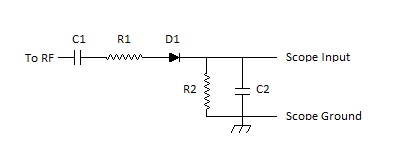Do You Really Need a Probe?
perfect probe
- does not distort signal
- does not load down the circuit
- rejects random noise pulses from other circuits
What Does a Probe Look Like from the Signal's Point of View?
Fourier analysis - any repetitive waveform is actually composed of a set
of overlapping sine wavesodd multiples of a base frequency such as 7 Mhz square wave would require sine waves at 7, 21, 35, 49MHz ...
each sine wave with its own amplitude
coax
has inductance, resistance and capacitance
these elements can cause attenuation and phase shift
with plain coax the output of probe will not resemble the input when non-sinusoidal signal is being observed
solution to unequal probe response to varying frequency is compensationthese elements can cause attenuation and phase shift
with plain coax the output of probe will not resemble the input when non-sinusoidal signal is being observed
Probe Compensation
minimal compensation circuit is parallel R-C circuit with variable CR values in the megaohm region
C values 5 to 25 pF
second resistor and perhaps other components used to add a x10 attenuation selection
voltage probes use compensation
Probe Types and Capabilities
Passive Probes
generally inexpensivegenerally use common BNC connector
all probes have ratings for voltage maximum and frequency response aka bandwidth
bandwidth may vary from 10 Mhz to 100 Mhz
two types of probe tips
- hooks to clip on leads
- pointed end
- compensation adjustment
- x1 or x10 attenuation selection
Active Probes
used where very low circuit loading is necessaryoften have FET connected to probe tip gives tip high resistance and low capacitance
typically include automatic calibration
High Voltage Probes
key design feature is safetyprobe body keeps user's hand removed from HV
most HV probes match a specific manufacturer's oscilloscope model and are not interchangeable
Current Probes
generally matched to a specific manufacturer's model or modelstwo models : AC and DC
limited bandwidth
AC-Only Probes
is simply a transformer with fixed primarywire carrying current is secondary
amplitude of current shown on screen is not very accurate
within bandwidth the waveform is accurate
DC Probes
usually uses a Hall Effect sensor
solid-stae device that detects magnetic fields
produces generally minute output voltage in response to field
range limited by saturation at both poles
most commercial units include an amplifier following the sensor
amplitude of current shown on screen is not very accurate
within bandwidth the waveform is accurate
produces generally minute output voltage in response to field
range limited by saturation at both poles
most commercial units include an amplifier following the sensor
amplitude of current shown on screen is not very accurate
within bandwidth the waveform is accurate
One More Probe Type for Hams
RF detector as an oscilloscope probe add-ondiode detector recovers transmitter's amplitude modulation

useful for AM to check modulation
useful for CW to see keying envelope